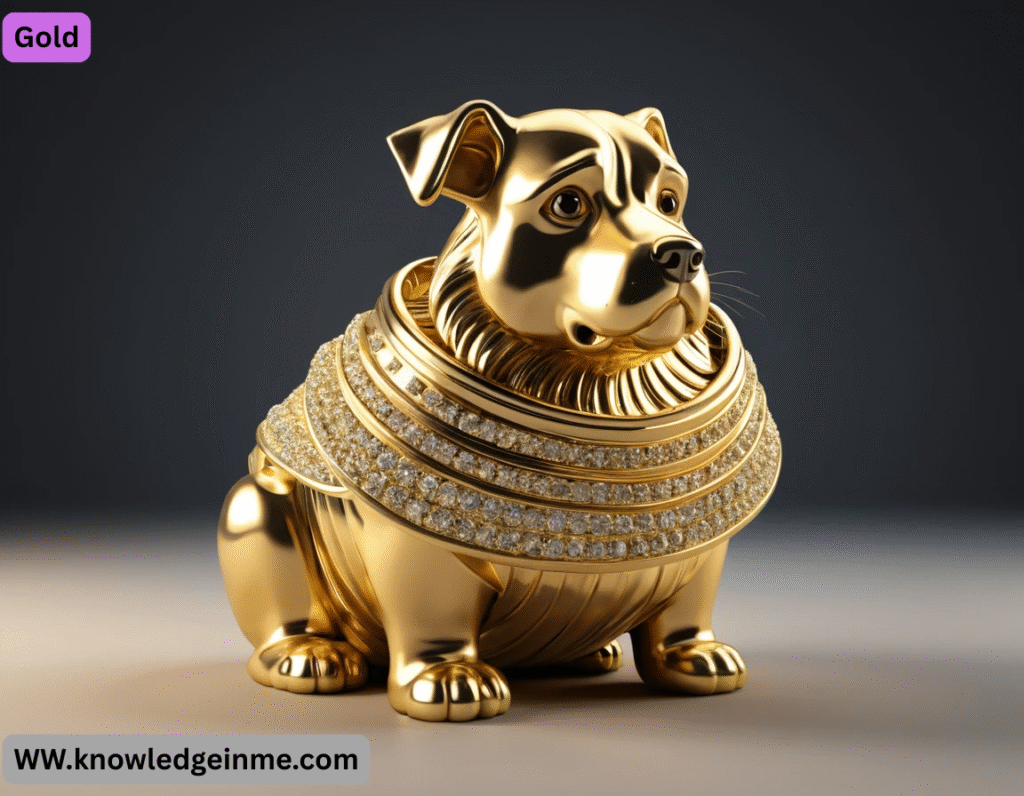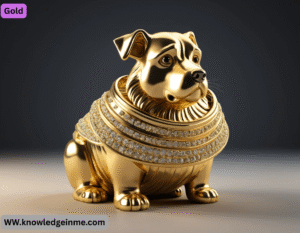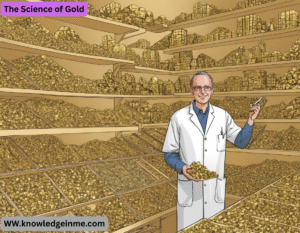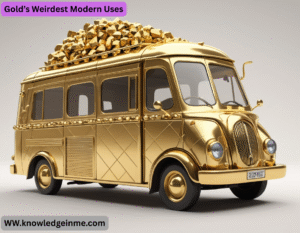Gold Here’s an even deeper dive into gold, covering obscure trivia, cutting-edge science, bizarre historical episodes, and futuristic applications:
Properties of Gold
- Symbol: Au (from Latin aurum)
- Atomic number: 79
- Density: 19.32 g/cm³
- Melting point: 1,064°C (1,947°F)
- Characteristics: Malleable, ductile, corrosion-resistant, excellent conductor of electricity and heat.
Uses of Gold
- Investments: Gold bars, coins, and ETFs serve as a hedge against inflation and economic instability.
- Electronics: Used in connectors, switches, and circuit boards due to its conductivity.
- Medicine & Dentistry: Used in dental fillings and certain medical treatments.
- Central Bank Reserves: Governments hold gold to stabilize currencies.
Gold Markets & Pricing
- Price Determinants: Influenced by supply/demand, inflation, interest rates, and geopolitical factors.
- Major Trading Hubs: London, New York (COMEX), Shanghai, Zurich.
- Benchmark Price: Set twice daily via the London Gold Fixing.
Mining & Production
- Top Producers: China, Australia, Russia, the U.S., and Canada.
- Extraction Methods: Includes placer mining, hard rock mining, and cyanide leaching.
- Recycling: Scrap gold (from jewelry and electronics) contributes significantly to supply.
Historical &
Significance
- Used as currency since ancient times (e.g., Egyptian, Roman, and Inca civilizations).
- Gold rushes (e.g., California 1848, Klondike 1896) shaped economies and migrations.
- Symbolizes wealth, power, and purity in many cultures.
Gold Standards & Modern Economics
- The Gold Standard (pegging currency to gold) was abandoned by most nations by the 1970s.
- Today, gold trades as a commodity, but central banks still hold reserves.
The Science of Gold
Why is gold yellow?
- Unlike most metals, gold absorbs blue light due to relativistic effects on its electrons (thanks to Einstein’s theory!), reflecting yellow and red hues.
Gold in space:
- Neutron star collisions produce gold—Earth’s gold may have come from cosmic explosions billions of years ago.
Isotopes:
- Gold has only one stable isotope (Au-197), but 36 radioactive isotopes exist (used in nuclear medicine).
Gold in Economics: Beyond the Standard
Bretton Woods (1944):
- The U.S. dollar was pegged to gold ($35/OZ); collapsed in 1971 when Nixon ended convertibility.
Modern Central Banks:
- Hold ~35,000 metric tons collectively (2024). The U.S. has the largest reserves (8,133 tons).
Gold vs. Bitcoin:
- Called “digital gold,” Bitcoin shares scarcity traits but lacks industrial/ornamental uses.
Extreme Gold Facts
Rarity:
- All gold ever mined (~209,000 tons) would fit into a 21m cube.
Ocean Gold:
- Seawater holds ~20 million tons of dissolved gold—but extraction costs exceed its value.
Edible Gold:
- 24-karat gold leaf is biologically inert and used in luxury foods (e.g., $1,000 sundaes in Dubai).
Popular Ways to Invest:
- Physical: Bullion, coins (e.g., American Eagle, Krugerrand).
- Paper: ETFs (GLD), futures, mining stocks.
- Digital: Gold-backed cryptocurrencies (e.g., PAXG).
Environmental & Ethical Issues
Mining Impact:
- Produces toxic waste (e.g., cyanide leaks); 20 tons of ore are needed for one gold ring.
Fairtrade Gold:
- Certified ethical mining ensures fair wages and reduced mercury use.
Gold in Pop Culture & Myths
Alchemy:
- Medieval chemists tried turning lead into gold (nuclear physics can do this—but it’s wildly uneconomical!).
Movies:
- Gold finger (1964) featured a plot to irradiate Fort Knox’s gold.
Olympics:
- “Gold medals” are actually 92.5% silver, plated with 6g of gold.
Future of Gold
Space Mining:
- Asteroids like Psyche 16 may contain $700 quintillion worth of gold (but legal/tech hurdles remain).
Nanotech:
- Gold nanoparticles are used in cancer treatment and pollution sensors.
Gold’s Cosmic Origins & Extreme Physics
Stardust Gold:
- A single neutron star merger can produce 100 Earth masses of gold in seconds. Most of Earth’s gold arrived via asteroid impacts after the planet formed.
Nuclear Alchemy:
- Smashing mercury-196 with neutrons in a reactor can create gold-197—but costs millions per gram.
Gold Rain:
- In 1952, a nuclear test in the Pacific vaporized $23M worth of gold sensors—later found as microscopic gold dust in the atmosphere.
Forgotten Gold Histories
Ancient Supercolliders:
- The Varna Necropolis (Bulgaria, 4500 BCE) contains the oldest gold artifacts ever found—crafted before the wheel or pyramids.
Roman Gold Mines in Wales:
- The Dolaucothi mines used Roman hydraulic mining—flooding entire valleys to expose gold veins.
The Great Gold Heist of 1855:
- Thieves stole $150M worth (today’s value) from a London-to-Paris train by picking the safe’s lock with a knitting needle.
Gold in Warfare & Espionage
Nazi Gold:
- The Yamashita’s Gold conspiracy claims Japan hid looted gold in Philippine tunnels; treasure hunters still search today.
Economic Sabotage:
- In WWII, the Allies dropped fake gold bars over Germany to crash public trust in the Reichsmark.
Gold’s Weirdest Modern Uses
Gold in Your Eyes:
- Retinal surgeons use 24-karat gold retinal implants to treat blindness.
Anti-Aging Skincare:
- Gold nanoparticles in face creams claim to reduce wrinkles (science is dubious, but Cleopatra slept in a gold mask).
Space Suits:
- Astronaut visors have a thin gold layer to reflect solar radiation.
The Dark Side of Gold
Mercury Pollution:
- Illegal gold mining dumps 1,400 tons of toxic mercury yearly into rivers (especially in the Amazon).
The “Blood Gold” Trade:
- In conflict zones like Congo, gold funds warlords—Apple, Tesla, and others face lawsuits over sourcing.
Gold’s Carbon Footprint:
- Mining 1kg of gold emits 20,000kg of CO₂—worse than Bitcoin!
Gold in the Far Future
Asteroid Mining:
- NASA’s Psyche Mission (2026) will study a $10,000 quadrillion gold-rich asteroid—though bringing it back would crash Earth’s economy.
Nanobot Gold Miners:
- Scientists are engineering bacteria like CURIAVIDUS METALLIDURANS to extract gold from e-waste.
Gold as a Superconductor:
- Under extreme pressure, gold becomes a superconductor—could revolutionize quantum computing.
Gold Myths Debunked
Midas Touch:
- Real gold turns black when exposed to alkali cyanide (used in mining)—no mythical “golden touch” needed.
El Dorado:
- The lost city was a ritual, not a place—a Muisca king coated himself in gold dust and dove into Lake GUATAVITA.
Fool’s Gold (Pyrite):
- Ancient miners thought it was gold—but it’s iron sulfide and crumbles when scratched.
How to Test Gold Like a Pro
Nitric Acid Test:
- Real gold won’t react; fakes dissolve.
Density Check:
- Pure gold weighs 19.3g/cm³—a counterfeit tungsten bar will be slightly lighter.
XRF Guns:
- Used by pawn shops to scan gold’s atomic signature in seconds.
The Most Expensive Gold Objects Ever
- The “Holy Grail” of Gold – A 4-inch solid gold model of a Thai royal barge ($12M).
- Gold Toilets – Maurizio CATTELAN’s America (2016) was stolen from Blenheim Palace.
- Gold-Infused Whisky – A bottle of Diva Vodka has gold flakes and costs $1M.






